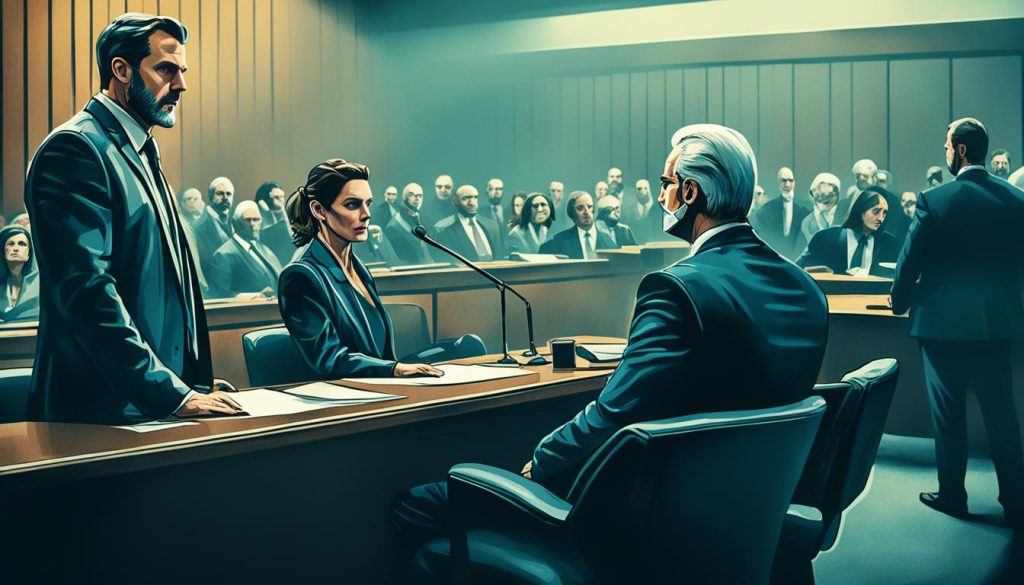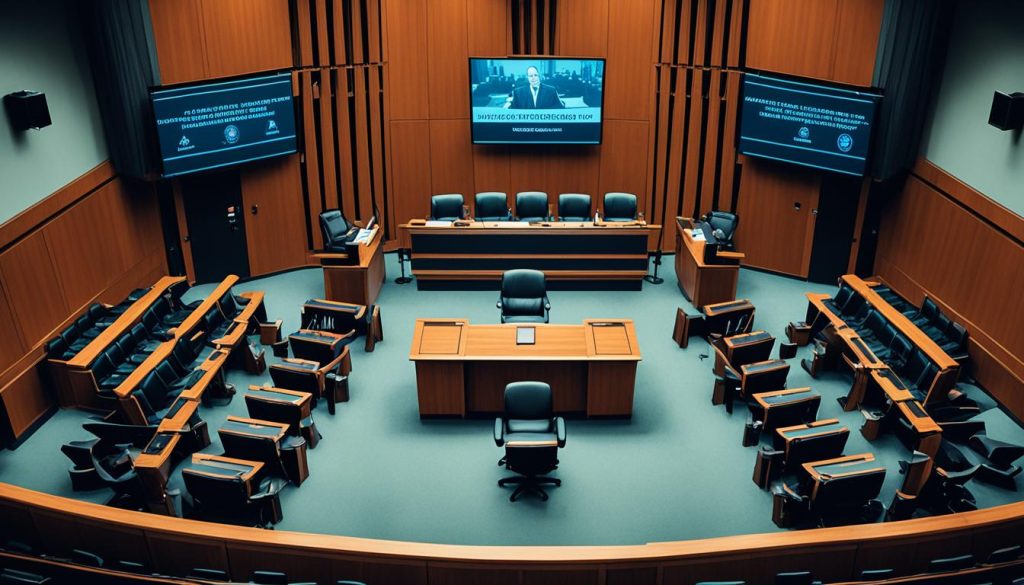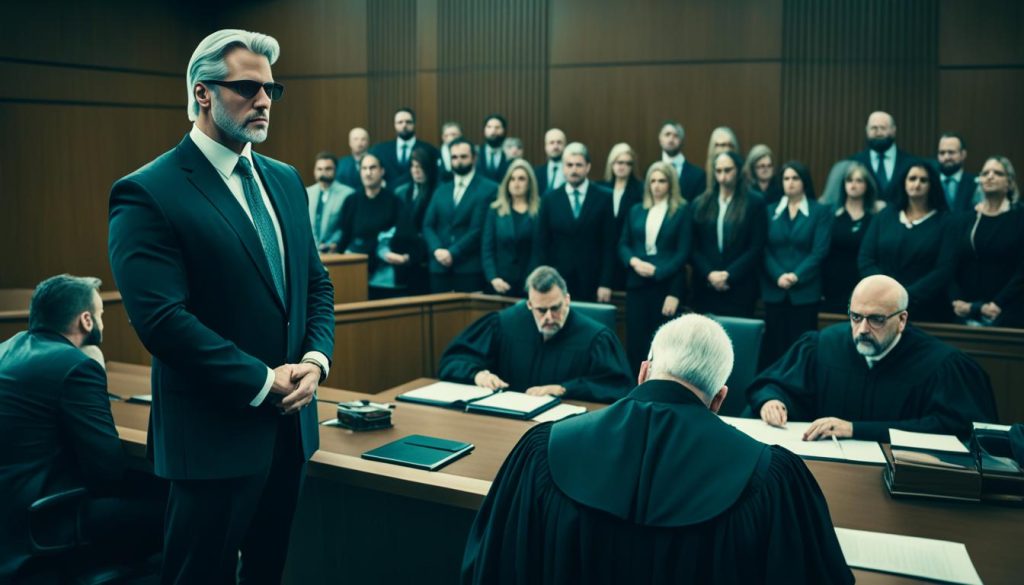Going through a criminal trial can be overwhelming, whether you’re the defendant or just watching. Knowing what happens can make you feel more in control. In the U.S., most criminal trials are open to everyone, and defendants can choose a jury trial1. A jury of 12 people then decides if the defendant is guilty or not based on what they hear from both sides2.
The time it takes to finish a trial can vary a lot. It could be just one day or go on for months. This depends on things like how many witnesses there are, how complex the case is, and if there are multiple defendants1. The trial has different stages, starting with the arrest or a notice to appear. Then comes the first meeting with a judge, an arraignment hearing, and finally, the trial itself1.
Key Takeaways
- Criminal trials in the United States are generally open to the public.
- Defendants have the right to a jury trial, where a group of 12 individuals determines their guilt or innocence.
- The length of a criminal trial can vary significantly, from a single day to several months.
- The trial process involves multiple stages, from the initial arrest or notice to appear to the final verdict and sentencing.
- Understanding the key aspects of the criminal trial process can help defendants and observers feel more informed and prepared.
The Jury Selection Process
The right to a trial by jury in federal criminal cases is a key part of our legal system, as stated in the Sixth Amendment3. During the jury selection, also known as voir dire, the judge and lawyers question potential jurors. They look into their backgrounds and biases to make sure they can be fair3.
Voir Dire and Challenges
Lawyers use different tools to make sure the jury is fair. They can challenge a juror for cause if they think they won’t be impartial. Or, they can use peremptory challenges without giving a reason4. Challenges based on race, ethnicity, or gender are called Batson challenges4.
- Felony charges, like murder and arson, have the most severe penalties3.
- Misdemeanors and summary offenses have less severe penalties than felonies3.
- In civil cases, common legal actions include personal injuries and contract disputes3.
- In civil cases, the plaintiff must show evidence stronger than the defense’s3.
- Juries are mainly used in Courts of Common Pleas3.
- The Supreme Court and Superior Court don’t use juries often, and the Commonwealth Court rarely does3.
- Jurors are chosen randomly3.
- After hearing the evidence, jurors discuss and decide the case’s outcome3.
- In criminal trials, the jury decides if the defendant is guilty or not and the penalty3.
- In civil trials, the jury decides if the plaintiff wins and sets damages3.
- If there’s no jury, the judge makes the final decision and can overrule the jury3.
| Jury Selection Criteria | Details |
|---|---|
| Jury Size | 12 jurors are usually picked for criminal cases, but civil cases can have 6 or 125. |
| Age Exemption | People 75 or older don’t have to serve as jurors5. |
| Jury Pool | The jury pool is made up of randomly chosen citizens who get a summons5. |
| Jury Duty Exemption | People who’ve served in the last three years might not have to serve again, with shorter exemptions for shorter service5. |
| Consequences of Non-Appearance | Not showing up for jury duty can lead to fines and/or jail for contempt of court5. |
| Post-Service Exemption | After serving, citizens are exempt for three years if they served three days or more. If less than three days, it’s one year5. |
The jury selection is key to ensuring fair trials4. Lawyers use challenges for cause and peremptory challenges to shape the jury4. They can also address discrimination through Batson challenges4. Once selected, the jurors are sworn in, and the trial moves forward4.
Opening Statements and Case Presentation
At the start of a criminal trial, lawyers on both sides give opening statements to the jury. The prosecutor explains the Opening Statements and the Prosecution’s Burden of Proof. The defense might also share their Defense Strategies6.
The prosecutor’s opening statement is key. It aims to tell a story that sets the case’s story structure6. They try to grab the jury’s attention, not just list facts6. In Texas, the rules for opening statements focus on the accusation and the evidence the State will present6.
Opening statements are crucial for the prosecution. They’re the first time jurors hear why the defendant should be found guilty6. Prosecutors should make their opening statements fit the case, giving jurors a clear roadmap for the trial6. The judge sets the time for opening statements, giving more time for complex cases6.
Prosecutors use stories and emotive language or visual aids to engage jurors6. Keeping the story simple, focusing on key characters and relationships, helps jurors understand better6.
The defense doesn’t have to make an opening statement or present evidence, as the defendant is assumed innocent7. But, they might speak after the prosecution’s witnesses, at the trial’s end7.
Presenting evidence is a key part of the trial, where witnesses and evidence are shown7. The defense can question witnesses after the prosecution, challenging their evidence and testimony7.
Closing arguments let both sides summarize the case before the jury decides7. The jury then talks privately to decide the verdict7.

The criminal trial is complex, with opening statements and case presentation being key8. Jurors must listen to the judge’s instructions carefully, as it’s their duty to follow them8. The prosecution must prove the case, presenting their evidence and witnesses first8.
Understanding opening statements and case presentation helps us see how complex trials work and the important roles of prosecution and defense678.,,
What to Expect During a Criminal Trial
Being part of a criminal trial means knowing the main steps and what happens at each stage. From Witness Testimony and Cross-Examination to Exhibits, Transcripts, and Courtroom Audio, each part is crucial. They all help find the truth and decide the case’s outcome9.
Witness Testimony and Cross-Examination
The prosecution goes first, letting witnesses share their stories. Then, the defense questions them, trying to make them seem less credible10. After that, the prosecution can ask follow-up questions to clear up any doubts10.
How long and complex witness testimony can be depends on the case. Some trials have a few witnesses, while others have many10. Remember, the defendant can choose not to speak, and the prosecution must prove guilt beyond doubt10.
Exhibits, Transcripts, and Courtroom Audio
Items like weapons or documents from the crime scene are shown as Exhibits in court. These Exhibits become public records and can be found through the court clerk’s office10.
Transcripts of what happened in court aren’t made unless someone asks for them. After 90 days, you can see and copy them10. Also, you might be able to hear the Courtroom Audio, if the court allows it9.
Trials can be very different, based on where they happen and the case details. Every trial is unique.9 Things like the crime type, the evidence, and the lawyers’ skills can change how the trial goes and how long it lasts10.

Knowing about a criminal trial helps you understand the legal system better. It also makes sure you know your rights. Whether you’re involved or just watching, being informed helps you make sense of what’s happening in court9.
Motions, Closing Arguments, and Jury Instructions
As the prosecution’s final witness speaks, the defense might make a Motion to Acquit11. They ask the judge to find the defendant not guilty because there’s not enough evidence. This motion is a key part of the trial, letting the defense question the strength of the prosecution’s case before the jury11.
After all evidence is presented, both sides give their Closing Arguments. The defense speaks first, then the prosecution11. This is their last chance to convince the jury. They summarize the main evidence and explain why they should win.
Then, the judge gives the jury Jury Instructions. These tell them about the laws, what proof is needed, and what to think about when deciding12. The judge might read these out, give them written copies, or even recorded instructions for later12.
With these instructions, the jury goes to the deliberation room to Deliberate and decide11. They look at the evidence and use the judge’s instructions to figure out if the defendant is guilty or not11.
The judge might ask the jury if they all agree on the verdict11. But this only happens if the people in the case ask for it11.
“The jury’s role is to carefully consider all the evidence presented and apply the law as instructed by the judge to reach a fair and impartial verdict.”
Knowing about motions, closing arguments, jury instructions, and deliberation is key for anyone going through a criminal trial. These steps make sure the evidence is looked at fairly, leading to a fair outcome for everyone111312.
Conclusion
The criminal trial process might seem complex, but knowing the main steps can help you feel more in control. From picking the jury to the final verdict and sentence, it follows a set process. This process is designed to protect the defendant’s rights and keep the justice system fair14.
It’s important to remember that the defendant is seen as innocent until proven guilty. The prosecution must prove your guilt14. Having a skilled criminal defense lawyer can greatly change your case’s outcome. They can present a strong defense and protect your rights during the trial15.
Even though the trial process might look overwhelming, knowing your rights and the steps involved can make you feel more ready. By paying attention, following the judge, and actively participating in your defense, you can help make sure the process is fair and just141615.
FAQ
What rights do defendants have during a criminal trial?
Defendants have the right to a jury trial. A jury listens to both sides and decides if the defendant is guilty or not. They can also choose to have a judge decide the case instead.
How long do criminal trials typically last?
Criminal trials can last from a day to many months. This depends on the number of witnesses and defendants.
How is the jury selected for a criminal trial?
Jury selection, or voir dire, involves questioning potential jurors about their backgrounds and biases. Lawyers can challenge jurors if they think they can’t be impartial. They can also remove jurors without giving a reason.
Objections to removing jurors based on race, ethnicity, or gender are called “Batson challenges.”
What happens during the opening statements of a criminal trial?
At the trial’s start, lawyers tell the jury what they think the evidence will show. The prosecutor goes first, as they must prove the defendant’s guilt. The defense doesn’t have to make an opening statement or present evidence, since the defendant is presumed innocent.
How do witness testimony and cross-examination work in a criminal trial?
Prosecution witnesses are questioned first and can be cross-examined by the defense. The prosecution can then redirect questions to the witness based on the defense’s cross-examination.
What happens after the prosecution’s last initial witness?
After the last prosecution witness, the defense may ask the judge to acquit the defendant if they think there’s not enough evidence. Both sides give closing arguments, and the judge explains the law to the jury.
How does the jury reach a verdict?
The jury deliberates and reaches a verdict. This verdict must be unanimous in most criminal trials.
Source Links
- Steps in a Florida Criminal Case: Process and Timeline | Orlando Defense
- What to Expect During a Criminal Trial in New York
- How the Courts Operate | Learn
- Jury Selection in Criminal Cases
- About Jury Service
- Starting out ahead with an opening statement | Texas District & County Attorneys Association
- Criminal Trial 101: What Happens and When
- Stages of Trial | 19th Judicial Circuit Court, IL
- What to Expect at a Criminal Trial
- Trial
- Northampton County Court of Common Pleas
- How Courts Work
- 234 Pa. Code Chapter 6. Trial Procedures In Court Cases
- Criminal Trial Process
- Closing Argument in Criminal Trials
- What are… The Steps in a Criminal Case

